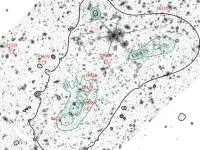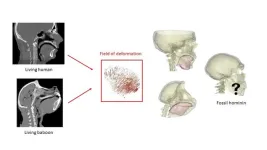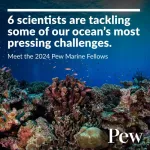(Press-News.org) UNIVERSITY PARK, Pa. — Scientists working with data from NASA's James Webb Space Telescope (JWST) have obtained the first full spectra of some of the earliest starlight in the universe. The images provide the clearest picture yet of very low-mass, newborn galaxies, created less than a billion years after the Big Bang, and suggest the tiny galaxies are central to the cosmic origin story.
The international team of researchers, including two Penn State astrophysicists, published their results today (Feb. 28) in the journal Nature. The spectra reveal some of the first visible light from a period in the universe known as reionization, which was powered by the arrival of the earliest stars and galaxies.
Normal matter in the universe started as a hot, dense fog made almost entirely of hydrogen and helium nuclei, explained Joel Leja, assistant professor of astronomy and astrophysics at Penn State and author on the paper. As it expanded and cooled, lone protons and electrons started bonding, forming neutral hydrogen for the first time. Then, roughly 500 to 900 million years after the Big Bang, that neutral hydrogen — which predominated in the early universe — began to separate again into ionized gas, spurring the creation of stars and galaxies and lifting the primordial fog so light could travel unimpeded through the cosmos for the first time.
“Something turned on that started pumping out very high energy photons into the intergalactic void,” Leja said. “These sources worked like cosmic lighthouses that burned off the fog of neutral hydrogen. Whatever this was, it was so energetic and so persistent, that the entire universe became re-ionized.”
By analyzing the spectra of young, low-mass galaxies, the scientists demonstrated that small galaxies were strong candidates for the “something” that sparked the reionization of the universe by heating the dense primordial gas around them and ionizing the once-neutral hydrogen.
“If the other low-mass galaxies in the universe are as common and energetic as these, we think we finally understand the lighthouses that burned off the cosmic fog,” Leja said. “They were incredibly energetic stars in many, many tiny little galaxies.”
The majority of galaxies in the early universe are expected to be relatively small, making studying their frequency and their properties extremely difficult, Leja added. Thanks to a technological feat made possible by the unique combination of JWST sensitivity and the gravitational lensing effect of the Abell 2744 cluster — nearby galaxies that act like cosmic magnifiers, distorting space and amplifying the light of background galaxies — it is now possible to determine the abundance of small galaxies and their ionizing properties during the first billion years of the universe.
"We found that small galaxies outnumbered massive galaxies by about a hundred to one during this epoch of reionization of the universe,” Hakim Atek, astrophysicist at Sorbonne University, researcher at the Paris Astrophysics Institute and first author on the paper said in a release. “These novel observations also reveal that these small galaxies produced a considerable amount of ionizing photons, exceeding by four times the canonical values usually assumed for distant galaxies. This means that the total flux of ionizing photons emitted by these galaxies far exceeds the threshold required for reionization."
The Penn State team led the modeling for the UNCOVER survey, which targeted the large foreground galaxy cluster that lensed the tinier, more distant galaxies. The Penn State researchers analyzed all the small points of light in the survey to understand the object properties as well as their likely masses and distances. That analysis was then used to guide later, more detailed JWST observations that drove this discovery, Leja explained.
Prior to these findings, there were number of hypotheses that identified other sources responsible for cosmic reionization, such as supermassive black holes; large galaxies with masses in excess of one billion solar masses; and small galaxies with masses of less than 1 billion solar masses. Researchers said confirmation of the hypothesis relating to low-mass galaxies proved particularly difficult, given their low luminosity, but the new findings offer the clearest evidence to date that low-mass galaxies played a central role in the reionization of the universe.
The researchers now want to extend the study to a larger scale to confirm that the particular location they analyzed is representative of the average distribution of galaxies in the universe. Beyond the reionization process, their observations provide insight into the process of early star formation, how galaxies emerged from the primordial gas — and how they evolved into the universe we know today.
Bingjie Wang, a postdoctoral scholar in astrophysics, is the other Penn State co-author on the study. A full list of authors and their respective institutions is available on the published paper. The researchers acknowledge funding and support from CNES, the Programme National Cosmology and Galaxies, CEA, the Cosmic Dawn Center, the Danish National Research Foundation, the Australian Research Council, the NOW, the European Commission’s and University of Groningen’s CO-FUND Rosalind Franklin program, the United States-Israel Binational Science Foundation, the U.S. National Science Foundation (NSF), the Ministry of Science & Technology, Israel and NOIRLab, which is managed by the Association of Universities for Research in Astronomy under a cooperative agreement with the NSF.
END
'Cosmic lighthouses' that cleared primordial fog identified with JWST
2024-02-28
ELSE PRESS RELEASES FROM THIS DATE:
Avian influenza virus is adapting to spread to marine mammals
2024-02-28
The highly pathogenic avian influenza virus H5N1 has adapted to spread between birds and marine mammals, posing an immediate threat to wildlife conservation, according to a study from the University of California, Davis, and the National Institute of Agricultural Technology (INTA) in Argentina.
The study, published in the journal Emerging Infectious Diseases, is the first genomic characterization of H5N1 in marine wildlife on the Atlantic shore of South America.
For the study, scientists collected brain samples from four sea lions, one fur seal and a tern found dead at the most affected sea lion rookery in Argentina. All ...
Study reveals accelerated soil priming under climate warming
2024-02-28
A first-of-its-kind study led by researchers at the University of Oklahoma highlights a crucial biosphere feedback mechanism and its effects on releasing soil carbon into the atmosphere.
Jizhong Zhou, the director of the Institute for Environmental Genomics and George Lynn Cross Research Professor in the School of Biological Sciences at OU, is the corresponding author of, “Experimental warming accelerates positive soil priming in a temperate grassland ecosystem,” recently published in Nature Communications. Zhou said the study is the first to utilize laboratory and field experimental ...
Improving children’s access to care could mitigate the health consequences of exposure to neighborhood violence
2024-02-28
A new collaborative study between Boston Medical Center, Brigham and Women’s Hospital, Boston Children’s Hospital, Hennepin Healthcare Research Institute, University of Pennsylvania, and Children’s Hospital of Philadelphia finds exposure to neighborhood violence among children was associated with unmet health needs and increased acute care utilization. Published in the American Journal of Preventive Medicine and based on nationally representative data on violence exposure and gold standard access to care measures from the National Health Interview Survey, this study shows that evidence-based interventions to improve access to care in communities ...
Molecular clusters on glial cells show they are more than our brain’s ‘glue’
2024-02-28
Neuroscientists at Fred Hutchinson Cancer Center have found that an often-overlooked type of brain cell called glia has more of a role in brain function than previously thought.
In the journal Cell Reports, Fred Hutch neuroscientist Aakanksha Singhvi, PhD, and her team report that a single glial cell uses different molecules to communicate with different neurons. Careful clustering of these molecules ensures that the glial cell can conduct a distinct “conversation” with each neuron. Through these molecular facilitators, glia can influence how neurons respond to environmental cues like ...
New method enables 3D tongue modelling, for example from fossilized hominin skulls, and might help understand the emergence of human speech
2024-02-28
New method enables 3D tongue modelling, for example from fossilized hominin skulls, and might help understand the emergence of human speech.
####
Article URL: https://journals.plos.org/ploscompbiol/article?id=10.1371/journal.pcbi.1011808
Article Title: Predicting primate tongue morphology based on geometrical skull matching. A first step towards an application on fossil hominins
Author Countries: France
Funding: This work is a production of the members of the team "Origins of speech" hosted at Sorbonne University - Institut des Sciences du Calcul et des Données. The funders had no role in study design, data collection ...
Pew names scientists from 6 countries as 2024 fellows in marine conservation
2024-02-28
PHILADELPHIA—The Pew Charitable Trusts announced today that it has selected six distinguished researchers as recipients of the 2024 Pew fellowship in marine conservation. The researchers—from Canada, China, Denmark, the Philippines, the United Kingdom, and the United States—join a community of more than 200 Pew marine fellows who have undertaken projects to deepen our understanding of the ocean and advance the sustainable use of marine resources.
“The world’s oceans have never been under greater threat. Humankind relies on healthy oceans in countless ways,” said Susan K. Urahn, Pew’s ...
For Type II diabetes prevention, tap into AI
2024-02-28
AUSTIN, Texas — Better prevention of Type II diabetes could save both lives and money. The U.S. spends over $730 billion a year — nearly a third of all health care spending — on treating preventable diseases like diabetes.
For the 98 million adults who are prediabetic and at risk of developing Type II diabetes, preventive treatments such as the drug metformin can help stave off the disease. But the medicines are expensive. With limited budgets, insurers and health care facilities need to allocate them to the patients they can help the most.
Currently, a health ...
New tool helps decipher gene behaviour
2024-02-28
Scientists have extensively researched the structure and sequence of genetic material and its interactions with proteins in the hope of understanding how our genetics and environment interact in diseases. This research has partly focused on ‘epigenetic marks’, which are chemical modifications to DNA, RNA, and the associated proteins (known as histones).
Epigenetic marks influence when and how genes get switched on or off. They can also instruct cells about how to interpret and use genetic information, influencing various cellular processes. Changes in epigenetic marks therefore significantly impact gene regulation and cellular ...
Think smoking cannabis won’t damage your heart? Think again
2024-02-28
The cardiac risks of smoking marijuana are comparable to those of smoking tobacco, according to researchers at UC San Francisco, who warn that the increasing use of cannabis across the country could lead to growing heart health problems.
The study found that people who used cannabis daily had a 25% increased risk of heart attack and a 42% increased risk of stroke compared to non-users.
Cannabis has become more popular with legalization. Recreational use is now permitted in 24 states, and as of 2019, nearly 4% said they used it daily and 18% used it annually. That is a significant increase since 2002, when 1.3% said they used it daily and 10.4% ...
Early-life exposure to air pollution and childhood asthma cumulative incidence
2024-02-28
About The Study: In this study of 5,279 children, early life air pollution was associated with increased asthma incidence by early and middle childhood, with higher risk among minoritized families living in urban communities characterized by fewer opportunities and resources and multiple environmental co-exposures. Reducing asthma risk in the U.S. requires air pollution regulation and reduction combined with greater environmental, educational, and health equity at the community level.
Authors: Antonella Zanobetti, Ph.D., ...





